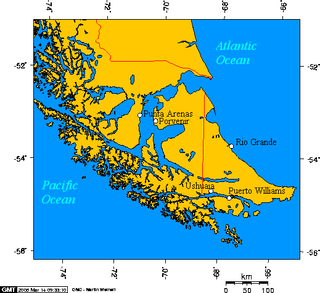
Tierra del Fuego is an archipelago off the southernmost tip of the South American mainland, across the Strait of Magellan.

Isla de los Estados is an Argentine island that lies 29 kilometres (18 mi) off the eastern extremity of Tierra del Fuego, from which it is separated by the Le Maire Strait. The island is part of the Argentine province of Tierra del Fuego, and of the department and city of Ushuaia. It has been declared an "Ecological, Historic, and Tourist Provincial Reserve", with access limited to tours from Ushuaia.

Ushuaia is the capital of Tierra del Fuego, Antártida e Islas del Atlántico Sur Province, Argentina. With a population of 82,615 and a location below the 54th parallel south latitude, Ushuaia claims the title of world's southernmost city.

Ushuaia – Malvinas Argentinas International Airport is located 4 km (2.5 mi) south of the center of Ushuaia, a city on the island of Tierra del Fuego in the Tierra del Fuego Province of Argentina.

Tierra del Fuego, officially the Province of Tierra del Fuego, Antarctica and South Atlantic Islands, is the southernmost, smallest, and least populous Argentine province. The provincial capital city is Ushuaia, from a native word meaning "bay towards the end".

Isla Grande de Tierra del Fuego also formerly Isla de Xátiva is an island near the southern tip of South America from which it is separated by the Strait of Magellan. The western portion (61.4%) of the island is in Chile, while the eastern portion is in Argentina. It forms the major landmass in an extended group of islands or archipelago also known as Tierra del Fuego.

Southernmost settlements are cities, towns, weather stations or permanent military bases which are farther south than latitude 45°S. They are closely related to the Southern Ocean or either the Roaring Forties or Furious Fifties. Antarctic bases are excluded due to not having a permanent population.

Beagle Channel is a strait in the Tierra del Fuego Archipelago, on the extreme southern tip of South America between Chile and Argentina. The channel separates the larger main island of Isla Grande de Tierra del Fuego from various smaller islands including the islands of Picton, Lennox and Nueva; Navarino; Hoste; Londonderry; and Stewart. The channel's eastern area forms part of the border between Chile and Argentina and the western area is entirely within Chile.

The Beagle conflict was a border dispute between Chile and Argentina over the possession of Picton, Lennox and Nueva islands and the scope of the maritime jurisdiction associated with those islands that brought the countries to the brink of war in 1978.
LRA Radio Nacional, also known as Radio Nacional Argentina, is the Argentine national radio station, and part of the national public media system. It started transmitting in 1937 as LRA Radio del Estado and changed its name to the current one in 1957. Since 1949, National Radio is also in charge of the Radiodifusión Argentina al Exterior, an international service that broadcasts in numerous languages.

Isaac Francisco Rojas Madariaga was an Argentine Admiral of the Navy and de facto Vice President of Argentina. He joined the Argentine Navy and had an unremarkable career until the 1946 election of Juan Perón.

Argentine postage stamps were first issued in 1858 by the Argentine Confederation and nationally by the new Republic's National Postal Service in 1862. Due to the continuing civil wars, a number of provinces and territories, particularly in the then-remote far north and far south, continued to issue their own postage brands and stamps for some time, afterwards; some of these issues have since become collectors' items.

Les Eclaireurs Lighthouse is a slightly conically shaped lighthouse standing on the northeasternmost island of the five or more Les Eclaireurs islands, which it takes its name from, 5 nautical miles (9 km) east of Ushuaia in the Beagle Channel, Tierra del Fuego, southern Argentina.
The region of the Beagle Channel, explored by Robert FitzRoy in the 1830s, was one of the last to be colonized by Chile and Argentina. The cold weather, the long distances from other inhabited regions, and the shortage of transport and subsistence, kept it far from the governmental task.

Mitre Peninsula is the easternmost part of Isla Grande de Tierra del Fuego, located in the very southeast of the island, with its easternmost point, Cabo San Diego, 29 km northwest of Isla de los Estados, from which it is separated by Le Maire Strait. In the south, the peninsula is bounded by the Beagle Channel, and in the north by the Argentine Sea. It is under 4000 km2 in area. The highest peak is Cerro Campana in the southern Montes Negros range with 1026 meters. Monte Atocha is nearby the southwest.
Operación Soberanía was a planned Argentine military invasion of Chile due to the Beagle conflict. The invasion was initiated on 22 December 1978 but was halted after a few hours and Argentine forces retreated from the conflict zone without a fight. Whether the Argentine infantry actually crossed the border into Chile has not been established. Argentine sources insist that they crossed the border.

The Treaty of Peace and Friendship of 1984 between Chile and Argentina was signed into agreement at the Vatican on 29 November 1984.

Between 1883 and 1906 Tierra del Fuego experienced a gold rush attracting many Chileans, Argentines and Europeans to the archipelago, including many Dalmatians. The gold rush led to the formation of the first towns in the archipelago and fueled economic growth in Punta Arenas. After the gold rush was over, most gold miners left the archipelago, while the remaining settlers engaged in sheep farming and fishing. The rush made a major contribution to the genocide of the indigenous Selk'nam people.















